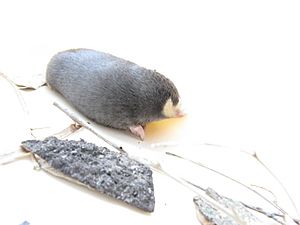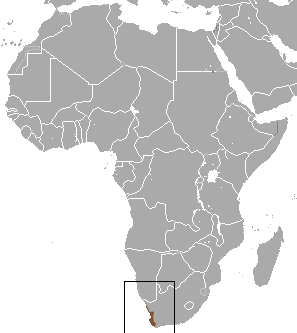Cape golden mole facts for kids
Quick facts for kids Chrysochloris asiatica |
|
|---|---|
 |
|
| Cape golden mole adult, showing the digging claw, absence of external eye and a hint of the iridescence of the fur. | |
| Conservation status | |
| Scientific classification | |
| Genus: |
Chrysochloris
|
| Species: |
asiatica
|
 |
|
| Cape golden mole range | |
| Synonyms | |
|
List
Chrysochloris asiatica bayoni De Beaux, 1921
Chrysochloris capensis Lacépède, 1799 Chrysochloris calviniae Shortridge, 1942 Chrysochloris concolor Shortridge & Carter, 1938 Chrysochloris damarensis Ogilby, 1838 Chrysochloris dixoni Broom, 1946 Chrysochloris elegans Broom, 1946 Chrysochloris minor Roberts, 1919 Chrysochloris namaquensis Broom, 1907 Chrysochloris rubra Lacépède, 1799 Chrysochloris shortridgei Broom, 1946 Chrysochloris taylori Broom, 1950 Chrysochloris tenuis Broom, 1907 Chrysochloris visserae Broom, 1950 Sorex auratus Vosmaer, 1787 Talpa asiatica Linnaeus, 1758 Talpa aurea Pallas, 1778 Talpa inaurata Pallas, 1777 |
|
The Cape golden mole (Chrysochloris asiatica) is a small, insect-eating mammal. It belongs to a special group called golden moles. These amazing animals live mostly underground. They are found only in the coastal areas of the southwestern and southern Cape in South Africa.
About the Cape Golden Mole
The Cape golden mole is a fascinating creature. It spends most of its life alone, digging tunnels. It's an insectivore, meaning it eats insects and other small creatures.
What Do They Look Like?
Cape golden moles have very soft, silky fur. Their coats can be blackish, slaty-grey, brown, or even pale fawn. This special fur helps them move smoothly through the soil.
- Size: Females are usually a bit smaller than males.
- Special Features: They have strong front paws. These paws are perfect for digging. They also have a unique nose shield. This helps them push through the dirt.
Where Do They Live?
These moles are found only in a specific part of the world. They live in the coastal regions of the southwestern and southern Cape. This area is in South Africa. They prefer to live in sandy or soft soil.
What Do They Eat?
Cape golden moles are always on the hunt for food. They dig shallow tunnels just under the surface. This is how they find their meals.
- Underground Meals: They mostly eat small creatures that live in the soil. This includes insects and even tiny lizards.
- Beach Snacks: Sometimes, they venture onto sandy beaches. Here, they look for small sea creatures. These can include amphipods and isopods.


